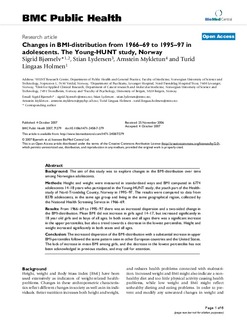Changes in BMI-distribution from 1966-69 to 1995-97 in adolescents. The Young-HUNT study, Norway
Journal article, Peer reviewed
Permanent lenke
http://hdl.handle.net/11250/1588817Utgivelsesdato
2007Metadata
Vis full innførselSamlinger
Sammendrag
Background: The aim of this study was to explore changes in the BMI-distribution over time
among Norwegian adolescents.
Methods: Height and weight were measured in standardised ways and BMI computed in 6774
adolescents 14–18 years who participated in the Young-HUNT study, the youth part of the Healthstudy
of Nord-Trondelag County, Norway in 1995–97. The results were compared to data from
8378 adolescents, in the same age group and living in the same geographical region, collected by
the National Health Screening Service in 1966–69.
Results: From 1966–69 to 1995–97 there was an increased dispersion and a two-sided change in
the BMI-distribution. Mean BMI did not increase in girls aged 14–17, but increased significantly in
18 year old girls and in boys of all ages. In both sexes and all ages there was a significant increase
in the upper percentiles, but also a trend towards a decrease in the lowest percentiles. Height and
weight increased significantly in both sexes and all ages.
Conclusion: The increased dispersion of the BMI-distribution with a substantial increase in upper
BMI-percentiles followed the same pattern seen in other European countries and the United States.
The lack of increase in mean BMI among girls, and the decrease in the lowest percentiles has not
been acknowledged in previous studies, and may call for attention.
